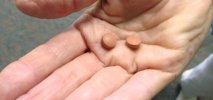New Treatment for Macular holes
Recent approval of Jetrea (Ocriplasmin) to treat symptomatic VMA (Vitreo Macular Adhesion) has opened up a new era in non surgical management of macular holes. Previously only a hospital based surgery was able to reverse the process of macular hole development but now a new drug can be injected into the eye painlessly in the office and within a few weeks the process reverses back to more normal vision levels.... more
FDA Approves ASRS Leader's ArgusŪ II Artificial Retina
On February 14, the FDA approved the Argus II artificial retina developed by ASRS Executive Committee and Board Member Mark S. Humayun, MD, PhD.
This breakthrough technology is the first ever to offer limited vision to patients with late-stage retinitis pigmentosa (RP).
Second Sight Medical Products (Sylmar, CA) manufactures the Argus II implant, which has 60 electrodes and a tiny camera mounted on eyeglasses to capture images.
The FDA approved Argus II for adults age 25 years or older with severe to profound RP. About 10,000 to 15,000 of the 100,000 Americans with RP will qualify for Argus II. Up to 4,000 patients a year can be treated with the device.
Macular degeneration and Aspirin?

Aspirin and Macular degeneration... is there an increase in the wet form of macular degeneration in those patients taking aspirin? The wet form develops quicker than the dry form. It may only be related to the fact that you are more likely to take aspirin if you have medical problems like stroke or heart attacks in the past and these conditions are more commonly associated with wet age related macular degeneration. ... more

Drink water not sodas
Submitted by Dr Peter Van Houten on Sun, 03/25/2012 - 05:21
Blog: How the soda effect was discovered
Treating diabetic macular edema (DME) usually involves taking diagnostic photos of the eyes using fluorescein angiography and using the images to guide laser treatment. This form of treatment has been the mainstay of treating DME for decades. It has saved a lot of vision. Treating these patients every year was not unusual however there was a subset that needed repeated treatment every three to six months or at twice the rate of other patients. It was thought that this was only due to the level of diabetic control that the patients were able to exercise. It was noted that some patients were under modest control but still had numerous micro aneurysms and leakage. Some had a petaloid like pattern of diffuse leakage that responded poorly to laser treatment. In the 1990's Diamox was tried to dry up some of this diffuse leakage and was met with mild to moderate success. The patients taking it noted the usual side effects of numbness and tingling of the fingers, lethargy and decreased appetite as the food did not taste as it used to. The one surprising side effect that was expressed was the complaint of the fact that sodas or carbonated drinks had a metallic after taste and that some of the patients stopped drinking them while others continued drinking them out of force of habit.
A special patient showed up in the clinic with a severe form of diffuse petaloid edema, severe coronary disease and severe ocular ischemia. He also was sulfa allergic and Diamox could not be used. Laser was of little help. Intra vitreous steroids had not been tried yet. A more through history of his diet showed a three cans of diet coke a day habit. On a whim, it was suggested that he change the sodas for water, the same volume to be drunk. In the course of 2 months, the petaloid edema resolved without Diamox or steroids. That caused a radical thought: did the sodas cause the edema to be worse and the side effect of Diamox use in other patients was causing them to stop soda consumption? To answer this question another patient offered the clue.
The second remarkable patient was your usual heavy set independent minded male who was known not to be the most compliant with the diet. The usual photos, fluorescein angiogram and laser treatment was done. Less than six months later this had to be repeated again. Talking to the patient it was discovered he was a two to three soda a day drinker. Further discussion with the patient convinced him to stop the soda consumption for a while but eventually he would revert back to the same habit and three months later would need another round of laser treatment. This went on for a few years until he was finally convinced to stop altogether and he had a two year hiatus of no laser treatment needed. He ultimately died of cardiac ischemic disease.
The unique high resolution imaging system that is in our office also shows the arterial changes that become evident with time. I am now about 70% accurate in looking at the photos and telling you how many sodas you drink on average. Another feature that is seen on the images of diabetics is the number of micro aneurysms. This number correlates well with the three month average blood sugar (A1c) however the more sodas you drink, the more aneurysms we see on the images for the same level of A1c and therefore the more retinal damage that is occurring.
Review of many electronic charts (19 years of EMR, 1765 soda questionnaires) revealed the following associations:
1: any carbonated drink has the same effect on leakage whether it is diet or regular.
2: the diabetic who drinks one 12 oz can of soda will need twice as many laser treatments for DME.
3: the non diabetic who drinks 2-3 cans of soda a day will wind up with a stroke or heart attack in 20 years.
4: the incidence of all forms of atherosclerosis of the small or large vessels is increased by soda consumption.
5: the effect on renal failure is pronounced and accelerated by soda consumption.
6: the younger diabetic with a high soda consumption will also cause an enlargement of the central foveal avascular zone. This causes loss of vision centrally and cannot be treated.
The mechanism of the damage is not known however there are many facts that surround the issue. Carbon dioxide is a very potent vasodilator of the retinal circulation. It is so potent that rebreathing CO2 in a paper bag is sufficient to pass a cholesterol crystal that is freshly stuck in an artery causing a branch or central retinal artery occlusion. The sodium in the drinks seem to elevate the blood pressure by 10-15 points on average. It has already been shown in the clinical literature that a 10 point rise in the average blood pressure in a diabetic will precipitate clinically significant retinopathy. It was thought that caffeine was the culprit however a woman's study in Boston comparing coffee, tea, soda and diet soda showed that the average blood pressure of the women went up in all groups however the coffee and tea drinkers got used to it and their blood pressure dropped back to normal after a while but the soda drinkers never came down.
It is hoped that this information would help the patients with this terrible disease. From a risk analysis viewpoint: if this information is correct, then it can save eye sight and extend life. If it is incorrect and the patient changes their habit from drinking sodas to drinking water, they at least save money. Either way, extensive and expensive medical studies are not needed to prove the point.






